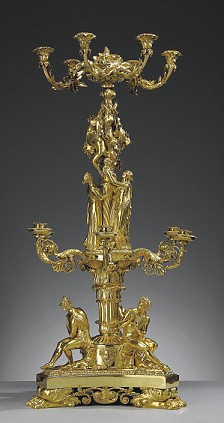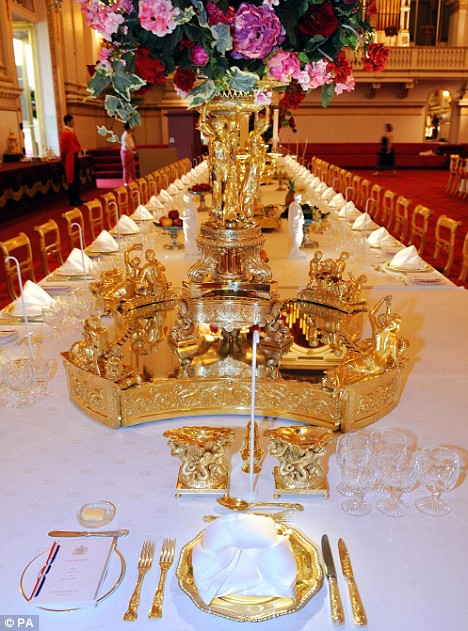Buckingham Palace has been open to the public since 1993.
Now the palace's ballroom has become the latest room to be opened up to the people.
The ballroom is where ther great state banquets are held - there have been 77 held there during the Queen's reign and 97 in total (of the other 20, 18 were held at Windsor Castle in Berkshire and 2 at the Palace of Holyroodhouse in Edinburgh) - and the public will be able to see the room as it is when it is laid for for such an occasion.
The popular monarch loves helping to set up the huge table's layout - and she also helped to set up this display for the public.
The Queen puts her Royal banqueting rooms on the tourist menu at Buckingham Palace for the first time
By Daily Mail Reporter
25th July 2008
Daily Mail
This is the scene which has greeted foreign monarchs, presidents and prime ministers - the Buckingham Palace ballroom prepared for a state banquet.
From Tuesday, it will not be by invitation only as it becomes the latest part of the palace opened to the public for two months over the summer.
Laid out are seats for 170, more than 2,000 pieces of polished silver-gilt cutlery, 1,104 glasses, 23 flower arrangements and 100 candles in candelabras.
The Queen toured the display yesterday, which will allow visitors to experience being a guest at an event normally reserved for visiting presidents, royalty and dignitaries.

Fit for a king: Ballroom decked out for a state banquet.
The Palace's ballroom has been decorated and the enormous dining table laid out with hundreds of pieces of tableware.
Her majesty Queen Elizabeth II spent around half an hour examining the display and other features of the event.
During her reign 77 state banquets have been held at Buckingham Palace, 18 at Windsor Castle and two at the Palace of Holyroodhouse in Scotland.
March's state banquet at Windsor Castle for French president Nicolas Sarkozy was the 97th hosted by the Queen since her accession to the throne in 1952.

The Queen lends Sir Hugh Roberts a helping hand before the opening of the exhibition
Kathryn Jones from the Royal Collection, who is curator of the exhibition, said about the palace's ballroom: 'In this room we wanted to give the impression of what it might be like to attend a state banquet.
'Only a tiny minority of the population will have been invited to one so giving everyone else the chance to experience the event was one of the ideas behind doing the exhibition.' The Queen was guided round the display by Sir Hugh Roberts, director of the Royal Collection.
Pieces from the Grand Service - a silver gilt dinner service made for the Prince of Wales, later George IV, in 1811 for £60,000 - were laid out for 89 guests on a large horse shoe table.

Queen inspects the dining table laid out with rare pieces
The table would normally be set for 170 guests but it was reduced to a manageable size for the exhibition.
Its decorations included silk flowers, bowls of artificial fruit and even artificial butter in tiny dishes - all of which would normally be real.
Mannequins dressed as footmen and poised to spring into action have been placed around the table while others dressed as yeomen of the guard wait at one end of the room.
Two buffet displays either side of the table feature a range of items including the Shield of Achilles - a large dish from the 1821 coronation banquet of George IV, and the altar dish used at the coronation of Charles II in 1661.
There were also displays of the pudding dishes made by the Minton factory at Stoke for Queen Victoria in 1877 and dessert plates, used for fruit, from an 18th century service acquired by George IV.
During the tour the Queen stopped to watch one of two screens showing a recording of a state banquet hosted last year in honour of President Kufuor of Ghana.
Enlarge
Enlarge
Crystal clear: A member of staff inspects a wineglass and a Mercury and Bacchus candelabra from the collection that will be on display
Looking at the figures on the monitor she inquired of Sir Hugh 'they look awfully dumpy'.
After meeting the small team who helped put the exhibition together she looked at static displays and another screen that showed the behind-the-scenes work of royal household staff - including chefs, footmen, pages, florists and housemaids - who ensure the highest standards of presentation and delivery.
The form of today's state banquet largely dates from the reign of Queen Victoria, who introduced the ceremony of the royal procession before the meal.
Guests are first received by the Queen and the visiting head of state in the Palace's music room and proceed to the ballroom.
The royal procession, led by the monarch and the foreign president or King, then makes its way to the banquet, preceded by the Lord Chamberlain and the Lord Steward.
Before dinner is served, the Queen proposes the health of her guest, who replies and proposes the sovereign's health.
During dinner, a programme of music is played by a military orchestra in the gallery, and at the end of the banquet pipers process around the room.
The Queen and the visiting head of state leave through the West Gallery, and guests move to the state dining room and the blue drawing room for coffee.
The summer opening of the state rooms at Buckingham Palace, including the state banquet display, is from July 29 to September 29.

Luxurious: Few ever see such a display
dailymail.co.uk
Now the palace's ballroom has become the latest room to be opened up to the people.
The ballroom is where ther great state banquets are held - there have been 77 held there during the Queen's reign and 97 in total (of the other 20, 18 were held at Windsor Castle in Berkshire and 2 at the Palace of Holyroodhouse in Edinburgh) - and the public will be able to see the room as it is when it is laid for for such an occasion.
The popular monarch loves helping to set up the huge table's layout - and she also helped to set up this display for the public.
The Queen puts her Royal banqueting rooms on the tourist menu at Buckingham Palace for the first time
By Daily Mail Reporter
25th July 2008
Daily Mail
This is the scene which has greeted foreign monarchs, presidents and prime ministers - the Buckingham Palace ballroom prepared for a state banquet.
From Tuesday, it will not be by invitation only as it becomes the latest part of the palace opened to the public for two months over the summer.
Laid out are seats for 170, more than 2,000 pieces of polished silver-gilt cutlery, 1,104 glasses, 23 flower arrangements and 100 candles in candelabras.
The Queen toured the display yesterday, which will allow visitors to experience being a guest at an event normally reserved for visiting presidents, royalty and dignitaries.

Fit for a king: Ballroom decked out for a state banquet.
The Palace's ballroom has been decorated and the enormous dining table laid out with hundreds of pieces of tableware.
Her majesty Queen Elizabeth II spent around half an hour examining the display and other features of the event.
During her reign 77 state banquets have been held at Buckingham Palace, 18 at Windsor Castle and two at the Palace of Holyroodhouse in Scotland.
March's state banquet at Windsor Castle for French president Nicolas Sarkozy was the 97th hosted by the Queen since her accession to the throne in 1952.

The Queen lends Sir Hugh Roberts a helping hand before the opening of the exhibition
Kathryn Jones from the Royal Collection, who is curator of the exhibition, said about the palace's ballroom: 'In this room we wanted to give the impression of what it might be like to attend a state banquet.
'Only a tiny minority of the population will have been invited to one so giving everyone else the chance to experience the event was one of the ideas behind doing the exhibition.' The Queen was guided round the display by Sir Hugh Roberts, director of the Royal Collection.
Pieces from the Grand Service - a silver gilt dinner service made for the Prince of Wales, later George IV, in 1811 for £60,000 - were laid out for 89 guests on a large horse shoe table.

Queen inspects the dining table laid out with rare pieces
The table would normally be set for 170 guests but it was reduced to a manageable size for the exhibition.
Its decorations included silk flowers, bowls of artificial fruit and even artificial butter in tiny dishes - all of which would normally be real.
Mannequins dressed as footmen and poised to spring into action have been placed around the table while others dressed as yeomen of the guard wait at one end of the room.
Two buffet displays either side of the table feature a range of items including the Shield of Achilles - a large dish from the 1821 coronation banquet of George IV, and the altar dish used at the coronation of Charles II in 1661.
There were also displays of the pudding dishes made by the Minton factory at Stoke for Queen Victoria in 1877 and dessert plates, used for fruit, from an 18th century service acquired by George IV.
During the tour the Queen stopped to watch one of two screens showing a recording of a state banquet hosted last year in honour of President Kufuor of Ghana.
Enlarge

Enlarge

Crystal clear: A member of staff inspects a wineglass and a Mercury and Bacchus candelabra from the collection that will be on display
Looking at the figures on the monitor she inquired of Sir Hugh 'they look awfully dumpy'.
After meeting the small team who helped put the exhibition together she looked at static displays and another screen that showed the behind-the-scenes work of royal household staff - including chefs, footmen, pages, florists and housemaids - who ensure the highest standards of presentation and delivery.
The form of today's state banquet largely dates from the reign of Queen Victoria, who introduced the ceremony of the royal procession before the meal.
Guests are first received by the Queen and the visiting head of state in the Palace's music room and proceed to the ballroom.
The royal procession, led by the monarch and the foreign president or King, then makes its way to the banquet, preceded by the Lord Chamberlain and the Lord Steward.
Before dinner is served, the Queen proposes the health of her guest, who replies and proposes the sovereign's health.
During dinner, a programme of music is played by a military orchestra in the gallery, and at the end of the banquet pipers process around the room.
The Queen and the visiting head of state leave through the West Gallery, and guests move to the state dining room and the blue drawing room for coffee.
The summer opening of the state rooms at Buckingham Palace, including the state banquet display, is from July 29 to September 29.

Luxurious: Few ever see such a display
dailymail.co.uk
Last edited: